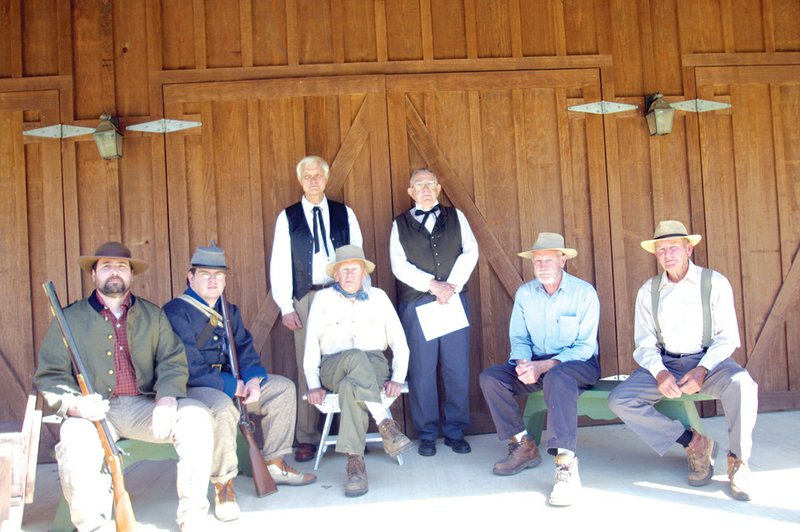Under a cloudless blue sky, a small crowd sat in folding chairs set up on the sprawling front yard of the historic Bozeman Plantation House to hear a “living history” of Civil War Days in Clark County.
The event, presented by the Clark County Historical Association, was held April 6 and 7. It told the stories of those people living on and around the plantation during the first week of April 1864. Bob Thompson, president of the association, said people sometimes forget the “hardship and misery” of those days.
“When Federal troops came to your house seeking supplies, they didn’t knock on the door, they walked on in,” Thompson said. “People knew the troops were coming and hid everything they could that Federals might want to take.”
The two-day event, sanctioned by the Arkansas Civil War Sesquicentennial Commission, was the association’s first Living History. The historic home of Michael and Lucy Bozeman, four miles west of Arkadelphia, was the scene of a skirmish on April 1, 1864. Confederate Gen. Joseph O. Shelby caught up with and attacked the rear guard of Union Gen. Frederick Steele’s invading army.
“It was the first time Clark County had truly been invaded by the North,” Thompson said. “We did not have any major Civil War battles here — we didn’t have a Jenkins’ Ferry — but we did have people who experienced these skirmishes, and they had a story.”
Visitors were treated to two scenes.
The first was held on the portico of the Greek Revival-style home, where six “actresses” portrayed local women who witnessed the passage of both Union and Confederate troops along the old Bethel Road — now Arkansas 26, or Old Military Road, which passes in front of the Bozeman Plantation — that first week in April.
Brenda Biehunko, who along with her husband, Bob, now own the Bozeman house, played Lucy Bozeman.
“We want people to feel what those ladies were feeling back then,” she said. “Their sons were away fighting in the war, and they were fearful they would lose them. Also there was the question of what would happen to their way of life — the Yankees were taking their food supplies, and they did not know whether they’d even have food the next year.”
Scene two took place at a barn, where a group of men condemned the invasion; made plans for survival; expressed hope for the Confederacy, and aided a pair of scouts.
Wendy Richter, archivist at Ouachita Baptist University, opened with an overview of the economic and social hardships placed on Clark County residents by the war.
“Early in 1864, Union leaders hatched a plan to defeat the Confederates in the southwest,” she said of the Red River Campaign. “Steele’s troops moved down the Military Road, crossed the Ouachita River … and then thousands of Union troops entered Clark County.”
She said Federals en route to Shreveport marched toward the Confederate capital in Washington, Ark. Skirmishes erupted at the Bozeman house, Spoonville (now Hollywood) and Okolona. One skirmish, the Battle of the Bees, took place in a severe thunderstorm. High winds overturned several beehives. The insects attacked the troops, forcing both armies off the battlefield.
Heavier skirmishes took place on April 3 and 4, as Federals fought for control of Elkins’ Ferry. By April 7, more heavy rains left the Union Army’s bridges and corduroy roads across the Little Missouri River “all afloat.”
Richter spoke of the psychological effect the presence of Union troops had on local residents.
“Just think about what this meant for citizens as they observed the thousands and thousands of soldiers in this area,” she said. “Nobody was really sure who was where. Supplies of all kinds were in great demand; [Union] troops seized what they needed. So perhaps the Bozemans and their neighbors can better tell their story about what happened right here in 1864.”
“We don’t know exactly what [area residents] might actually have said,” Thompson said of the scripted dialogue, “but we do have historic records of the events themselves — diaries and other documents. We wanted to create something as factual as possible.”
In scene two, a group of men described the invading force, with one recommending turning a “pack of dogs” loose on the Federals. “Especially ole Chester, he’s the meanest one of the whole bunch.”
“The Yankees took all of our animals, even the chickens and the geese,” said another. “I think this country is going to hell in a handbasket since that damn Lincoln became president. I can’t wait to run them Yankees to hell.”
One pointed out that Steele had “taken over Arkadelphia. If they keep going like that, we’re gonna have a hard time, but if we get ’em on a level playing field … they gonna have a lot of trouble.”
Visitors were then allowed to view the Bozeman family cemetery, where three known Confederate soldiers are buried.
Thompson said the “magnitude” of the invading force was expressed in the performances.
“Eight-thousand Union troops entered Clark County,” he said. “They were in a wagon train four to six miles long. They marched right up this road, foraging what they could from the population.”
He said Union troops entered the Bozeman house itself — but did not take anything. “There was molasses upstairs and it was running down the walls, so I’m sure there were some anxious moments,” Thompson said, “but the troops took nothing. It has been suggested that they left without taking anything because of some Masonic books that Lucy Bozeman had.”
Brenda Biehunko said she and her husband have owned the house for 20 years. “We love it, it’s a gorgeous place,” she said of the house, which was completed in 1849. “We’re very happy to do the re-enactment here. It’s good to bring it all back for people.”
